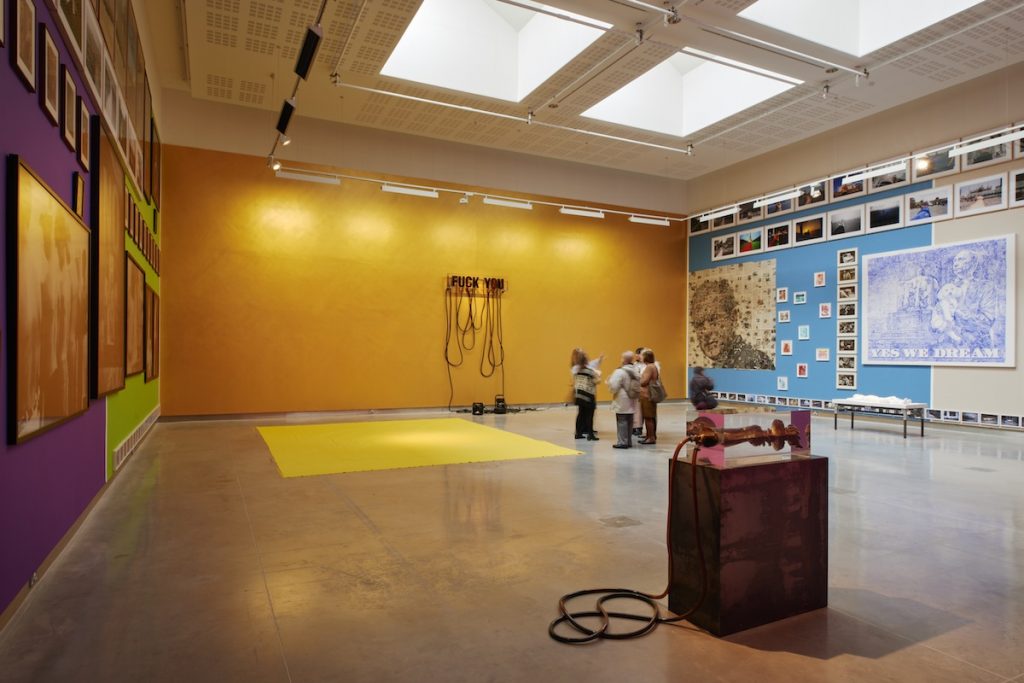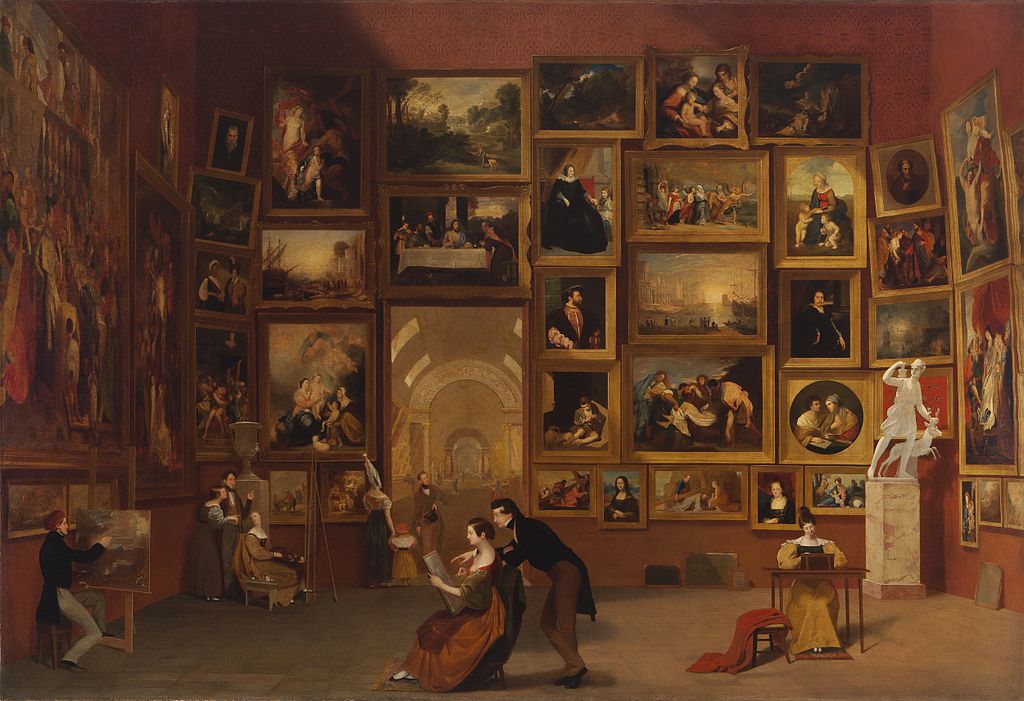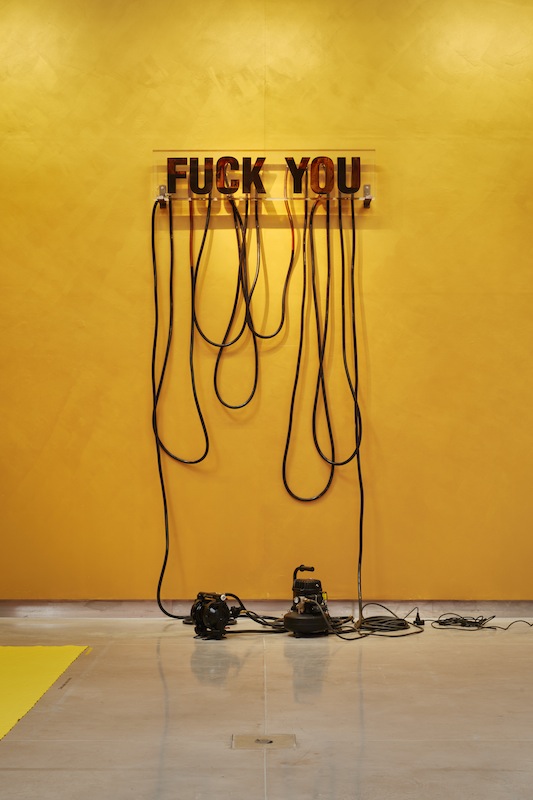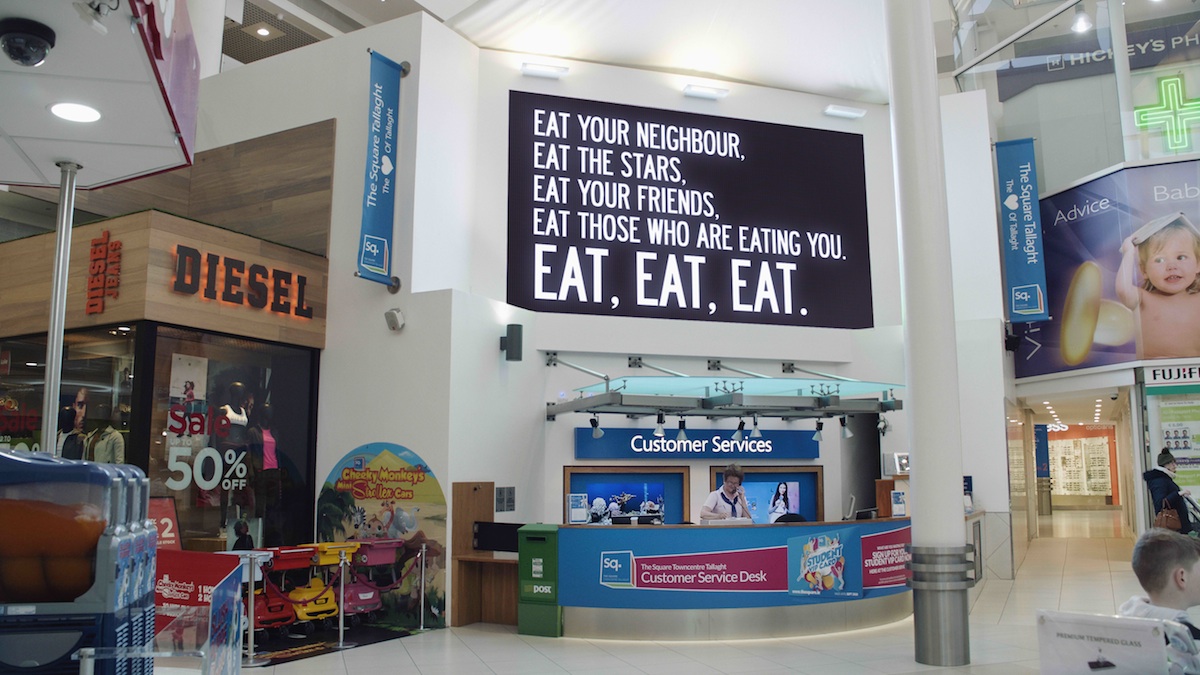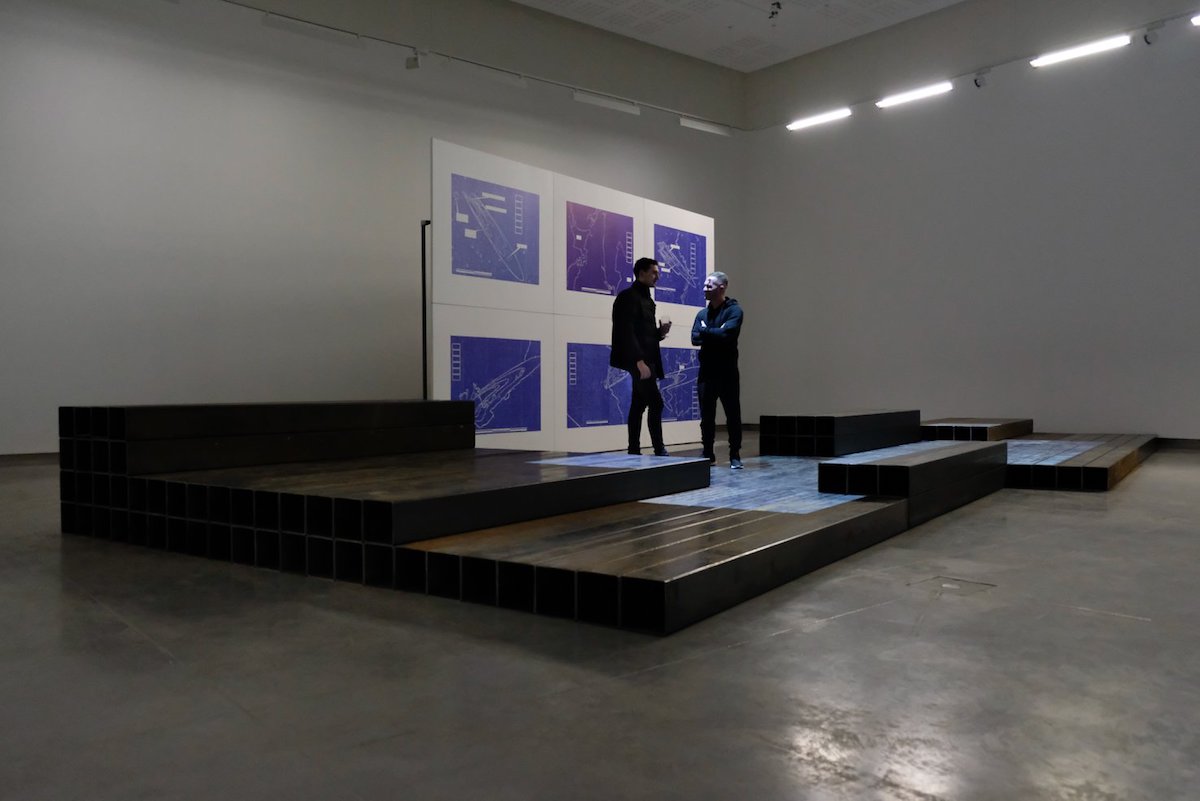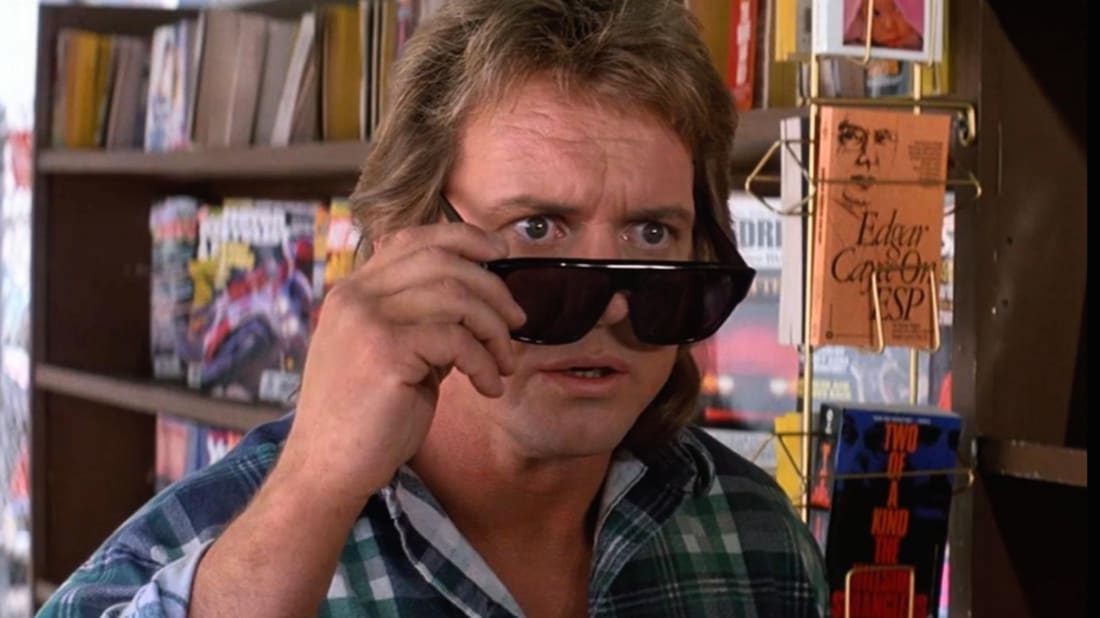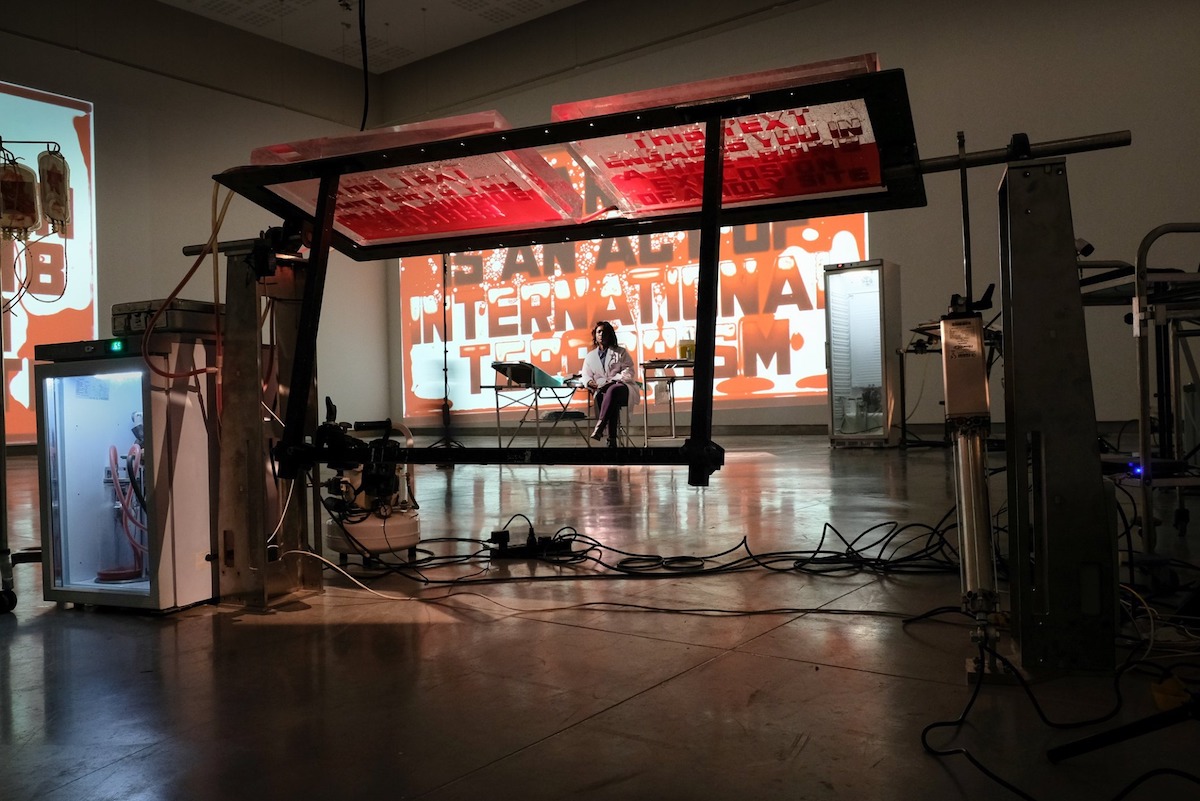In February of this year opened Andrei Molodkin’s Bloodline at Rua Red. The exhibition was the seventh and last installment of a collaboration between the south Dublin contemporary art space and the art organisation a/political begun in October 2017. Philip Kavanagh looks back on this long and fecund engagement and finds an incentive to revisit the relationship between the formal and the political.
In his 2009 article ‘Self-Design and Aesthetic Responsibility’, Boris Groys points to the great dissatisfaction felt within contemporary art when it fails to transcend itself and affect politics.[1] The means by which the politicisation of art is considered quickly becomes predictable, trapped between either a vague hope it might succeed in achieving some political efficacy, and disappointment at its continued failure to do so. An implied incapacity on art’s part to become political emerges, but for Groys no such incapacity actually exists. The ‘disappointment’, he argues, actually emerges due to the fact that “when art becomes political, it is forced to make the unpleasant discovery that politics has already become art – that politics has already situated itself in the aesthetic field”. If this was prophetic in 2009, then today, in the age of the political instagram staffer, it is self-evident. What is less clear though is whether political art has rectified its proclivity for disappointing its practitioners; if it has reconciled itself in these now conflated fields. I would suggest that these tendencies have largely persisted, but in a recent multi-exhibition collaboration between South Dublin’s Rua Red and the political art organisation a/political, the throes of some shift can be seen.
The exhibition How to Say it the Way it is! [figure 1] – staged in October 2017 – marked the beginning of this project, one that quickly became a mainstay of political contemporary art in Ireland. Maolíosa Boyle, director of the community orientated Rua Red, had worked with a/political previously. There were shared values around public engagement she noted, and she knew instinctively that they would be interested in working with her in Tallaght.[2] As an entity they work with political artists, supporting them with their more contingently stratified projects. While it has offices in London, the organisation’s site of production is in Maubourguet – west of Toulouse – in the shadow of the French Pyrenees. Referred to as ‘The Foundry’, it is a former site of industry with a history tied to the political maelstroms of the twentieth century. An ironworks that opened its doors in 1870, it produced armaments throughout the First World War. Following the armistice this area of southern France became an adopted home for many communists fleeing the fascist springs of Italy, and later those of Spain. It is now a site of experimental art production, and a great deal of the politically-minded art that has been produced there since 2017 has been made in response to Rua Red and Tallaght – art that has had a highly considered formal character.
Brian O’Doherty wrote about the shock that images like Samuel Morse’s Exhibition Gallery at the Louvre (1833) [figure 2] pose to our contemporary aesthetic sensibilities: the “barbarity” of “masterpieces as wallpaper”, as he put it, “each one not separated out and isolated in space like a throne”.[3] It was precisely this aesthetic barbarity that How to Say it the Way it is! played with. The curator Franko B acutely addressed political art’s tendency to lose political efficacy through notoriety, and did so by hijacking the loaded salon aesthetic and appropriating it as a formal strategy. Some 32 artworks by political heavyweights like Santiago Sierra, Gustav Metzger and Barbara Kruger were cramped together in claustrophobic display, on distractingly vibrant walls, and made to compete for position. Ai Weiwei’s Study of Perspective (1995) was ‘skied’. It skirted where the gallery wall met the ceiling, as if it were a snubbed salon work unworthy of the best gallery real-estate. Disparate works like Sierra’s infamous 160cm line tattooed on 4 paid people (2000) and Andre Serrano’s Grand Dragon of the Invisible Empire (1992) were shown together without a breath of compassionate air between them. The diminished political dimension of these works was redirected back into the internal politics of the exhibition itself. Constant allusions to the barbarity of this ‘nineteenth century eye’ alluded further that this eye still exists, incognito, at home in the sort of modern retina where secret taxonomies antithetical to the pursuit of a genuine political art are hidden. The activity here was in the formal character of the curatorial choices. The individual works were instrumentalised to this end, often brutally so. It was cold, delirious, and in its ironies and formal absurdities there was a pointed redress. Reconsidering Groys, political art was certainly not presented here as having rectified its proclivity for disappointment. In How to Say it The Way It is! political art is a hostage with one hand tied behind its back. Untying that hand means looking again to a relationship that has been one-sided recently: the relationship between the formal and the political.
Since these striking beginnings there have been six further exhibitions. Off the back of his work Fuck You (2011)[figure 3], featuring prominently in Franko B’s group show, Andrei Molodkin delivered the first solo effort of the collaboration in the form of Fallout Pattern in February 2018. The Spanish art duo Democracia then presented Order in April of the same year. 2019 saw three further interventions with Finnegans Woke by Kennardphillipps (2019), The Second Coming by Kendall Geers (2019) and Franko B’s Unloved (2019). Bloodline, the final show in the collaboration and Molodkin’s second opened in February of 2020, but was unfortunately forced to close early due to the outbreak of COVID-19. Whilst by no means contrived, much of these other works shown during this collaboration shared with Franko B’s opener an interesting dynamic between socio-political concern and formal consideration. Democracia’s Order, for example [figure 4], was a three-channel opera that presented societal oppressions in a melodrama filmed across locations in Houston, London and Tallaght. It dealt with how exploitations of race and class intersect with late stage capitalism as embedded phenomena, encoded into normality, and sought to stage an exposé of such structural exploitations. Relative to this formal character being discussed, the second act was of particular interest. Filmed in The Square shopping centre opposite the gallery, the work followed a children’s choir wearing garb similar to the robes in The Handmaid’s Tale (2017), and as such introduced itself as something strange or dystopian. They sing in the shopping centre, and we see billboard messages that juxtapose the casual music with authoritative slogans in place of the usual advertisements: EAT, CONSUME, OBEY, much like the nineteenth century salon in How To Say It The Way It Is!, the operatic form here was seemingly culturally antithetical to the sort of socio-political critiques at stake. Subsequent exhibitions too involved strange formal choices, but the works of Andrei Molodkin in particular consistently involved highly active forms, and are worth discussing in some detail.
Along with Franko B, who has had considerable involvement, Andrei Molodkin should now be a name synonymous with the project. His first exhibition Fallout Pattern [figure 5], a rather dour installation, was based on a set of Wikileaks documents that detailed the impact of a potential US nuclear attack on Russia. This arrangement of projected documents, square tube steel, soundscapes and cartographic drawings appeared in Rua Red’s gallery 1 as a main feature. In the adjacent gallery 2 though, students from the local Institute of Technology, Tallaght, were busy researching “systems that enable the world to function”. This entirely responsive feature acted as a performative lab in relation to the installation. Through it, something approximating a more inclusive political engagement with information was staged in opposition to the wider exhibition. Reasonable doubts about such a didactic approach notwithstanding, an interesting relationship between this grass-roots snooping and the formal rigor of the main feature developed as the work produced in gallery 2 began to make its way into the main exhibit.
As an artist, Molodkin is known for working with extremely charged materials. He works with oil, as we saw in Franko B’s group show, and also with blood (as we would come to see), but in Fallout Pattern information itself was the currency. The work explored how the very act of accessing information is an overtly political one by virtue of its opposite – the sociological exclusion from it. While it operated from a less visceral material base than that of blood or oil, it visibly touched off Molodkin’s deep-rooted concern with power as it manifests in language, and did so without the added complexity those more charged materials carry, materials that are for him particularly loaded.
A former Soviet soldier, he has been explicit throughout his career about how his service in the military has informed his art practice. As part of his work detail in the mid to late 1980s, he would transport oil-slicked munitions and armaments across Siberia. He recalls in an interview in Dazed and Confused how he once escorted some gigantic oil cisterns. He said that they (the soldiers) would be covered in oil. They would heat their cattle cars using it, and even ingest it to get high in lieu of vodka.[4] For him, oil holds a wealth of association at a base level of materiality level, performing as a transformative substance beneath its usual geopolitical instrumentalisation. His fascination with blood too comes from his military service. When a fellow soldier tragically shot himself in the heart, he left a 40 metre trail of blood along the road. No one could cross over it out of shock and fear, he recalled, describing the act as his friend’s last artistic gesture.[5] Contextualise these events within the Soviet Union’s collapse. Consider then also the abrupt influx of a heightened predatory capitalism that rushed in to replace it. If a person were likely to develop an imagination of politics stripped of ideological veneer, Molodkin would be the candidate I’d back. His ‘formal idea’ (his words) is one in which purportedly universal concepts like justice, or democracy are like reservoirs. They are filled, emptied and then refilled by political praxis that animate these concepts for their own structural drives.[6]
That there is a critical and self-aware referencing of the constructivist tradition in his work is a usual point of discussion, but the Russian Formalists and their artist acolytes like Malevich seem much more pertinent to Molodkin’s thinking. Something like de-familiarisation as described by the Formalists is at play in Molodkin’s process. In fact it is present through much of the collaboration in general. Looking again briefly at Democracia’s Order, this formal technique is both used and referenced simultaneously. Consider again the brainwashing billboards in its second act: EAT. OBEY. CONSUME. These phrases will be familiar to some as central to another piece of dystopian entertainment, John Carpenter’s They Live (1988), in which the protagonist John Nada can, with the help of magic sunglasses, see these true authoritative directions behind the glossy consumerist billboards that clutter Los Angeles. The fact that the character’s name is ‘Nada’ wouldn’t have escaped the Spanish duo when they referenced it. ‘Nada’ means ‘nothing’, and the protagonist is positioned as looking from nowhere, outside ideology – a de-familiarisation these zero-device glasses afford him [figure 6]. Perhaps lyrically, in lieu of the glasses from They Live, Molodkin would still tell you what he sees. Making the invisible visible is not only an artistic ideal in his work but a formal principle, and nowhere is this more pervasive than in Bloodline.
The smell of blood was in the air. He had littered medical furniture and paraphernalia around Rua Red’s main gallery, lacing it with a dry, laboratory-like sterility [figure 7]. In and about this scattering were clear acrylic slabs in which three dimensional text is hollowed and set. Mounted in hydraulic assemblages, these slabs were filled with human blood pumped from nearby refrigerators. By way of these hydraulic limbs, the blood was agitated in modest arcs and coaxed into movement. It pooled in the otherwise transparent text, bringing it to the point of legibility, before falling out again on the mechanism’s returning arc. Cameras were mounted underneath the assemblages. Imagery was generated from them in real time and cast onto the gallery’s two huge adjacent walls. Amidst this luminance the medical objects sat in semi-darkness, their strange personless operations faintly illuminated by silky reflections. Cast onto the left wall, blood flowed in and around text, congealing and bubbling with slow fluidity. The phrase read: ‘This text engages you in a time-bomb explosion of a holy site’. On the right wall, the other text read: ‘this text converts you into a suicide bomber’. Provocative, divisive, at least that’s the idea when such phrases proliferate in the media. This isn’t newsprint however, or side-crawling headlines on the evening news. It is blood, our blood. The public has donated it, and have been told with tongue in cheek that they are ‘complicit in an act of terrorism’.[7] Bloodline unmasks hidden politics through an elegant dichotomy of visible and invisible. Through the lens of its inverted tropism, we are invited to consider how we normally absorb such politicised and pointed rhetoric, how it functions fluidly as a contrived deterrent against dissonance, and how, most importantly, we are complicit in enabling its power.
Discussing the formal character of political art hasn’t been popular for some time. Embedded in the drive towards an ethical art activism, for example, is the idea that the aestheticisation of politics was counter-productive to the larger project, as it distracted from practical goals and valorised the aesthetic form. Scrutinised further, the form of a work of art became incidental, tolerated only if it behaved and didn’t interfere with the real business at hand. This panning consolidated, grounded by many prominent thinkers in the field. Adrian Piper’s condemnation of formalism for example, as Alan Ruiz notes in his essay ‘Radical Formalism’, describes it as “a self-enclosed value system informed by a ‘socioeconomically determined aesthetic’ and ‘Eurocentric’ model of education”.[8] Piper’s criticism here, while of course valid relative to formalism as a movement, is indicative of a wider art-historical perspective that criticised formalism on grounds that were by no means rooted in form itself. As Susan Wolfson notes: “It was not attention to form per se that was discredited; it was the impulse to regard it as the product of a historically disinterested, internally coherent aesthetics”.[9]
The aforementioned Ruiz is an artist who sees clear distinctions between form as a principle and the historical contexts of this principle’s development. For him: “What is at question here is not simply whether there is a presence of form in these works, but rather a question of its value in relationship to a work’s other properties, and how form plays a profound, and at times unacknowledged, role in our understanding these works”.[10] If we problematise the distinction between form and content, address the mutual contingencies between them that have been downplayed within political art, we might find a “radical formalism that neither fetishizes historical precedents nor abandons them completely in normative Modernist succession”.[11]
Maybe it is a reaction to our current situation, but it is compelling to interpret something like the collaboration between a/political and Rua Red through the lens of a new formalism, a formalism of détournement, as Ruiz put it, where the emphasis is on what the work does and not what it says. It could well be that exhibitions like How To Say It The Way It Is!, like Bloodline, succeed through this lens as ‘carriers of the political’; that they denote a potential space for new imaginings of form. Maybe these imaginations could be applicable on an altogether larger scale, where political artists might be afforded new opportunities to overcome their self-imposed self-disappointment. Conceptualising a new stable global economy post COVID-19 for example, would certainly qualify as a formal problem that requires some imagination.
